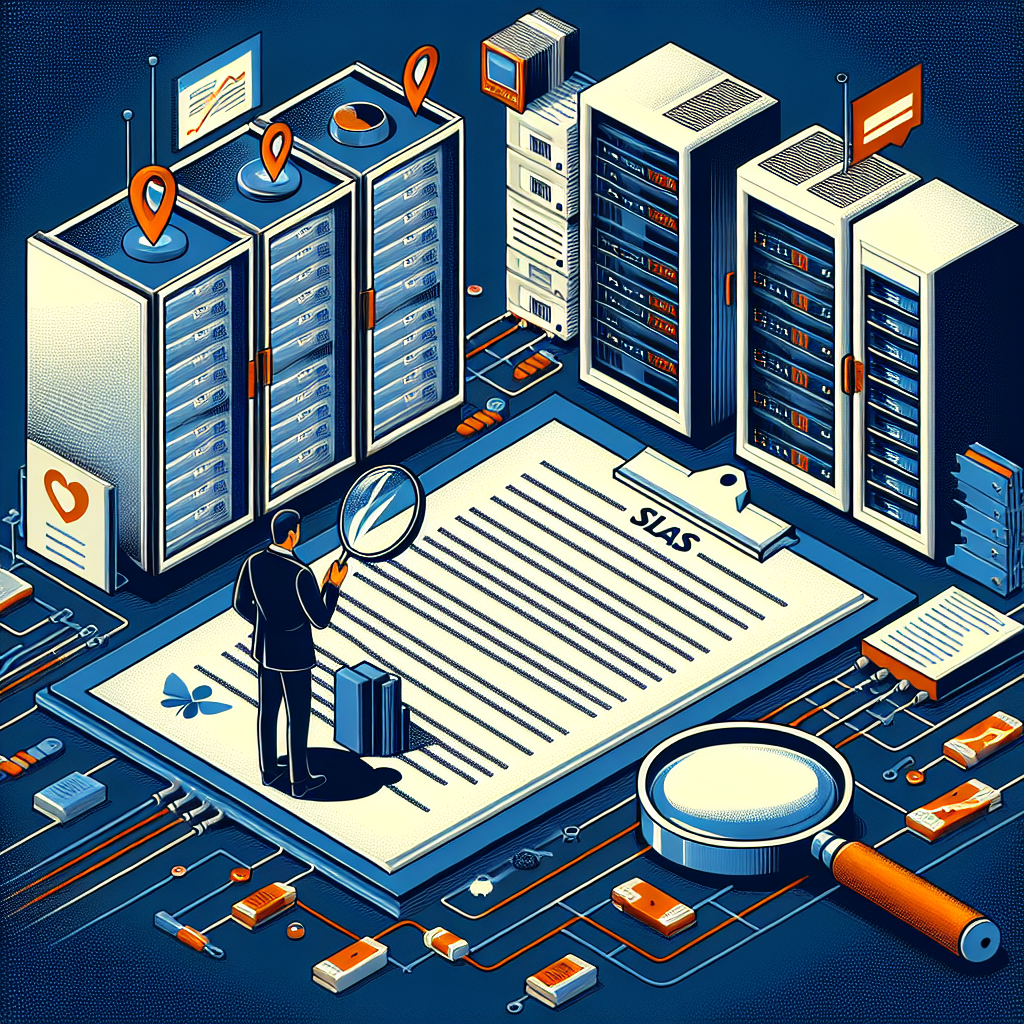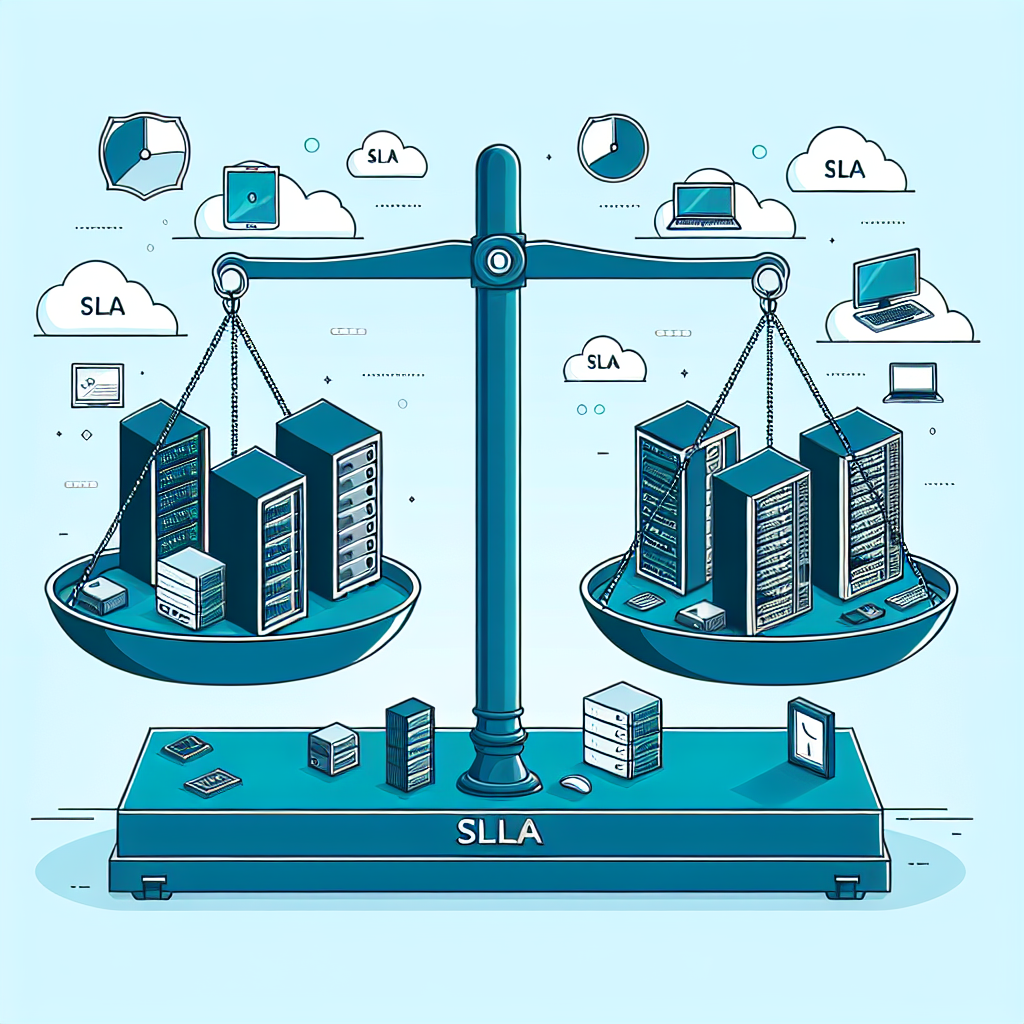Your cart is currently empty!
Tag: Service

Common Pitfalls to Avoid When Drafting Data Center Service Level Agreements
Data centers are critical components of modern businesses, providing the infrastructure necessary to support their operations. As such, service level agreements (SLAs) are essential to ensure that data center services meet the needs and expectations of the organization. However, drafting a data center SLA can be a complex process, and there are several common pitfalls that organizations should avoid to ensure that their agreements are effective and enforceable.One common pitfall to avoid when drafting a data center SLA is failing to clearly define the services being provided. It is essential that the SLA clearly outlines the scope of services, including the specific services that will be provided, the performance standards that will be met, and the responsibilities of both the data center provider and the organization. Failing to clearly define the services can lead to misunderstandings and disputes down the line, so it is important to be as specific as possible in the SLA.
Another common pitfall is failing to establish clear performance metrics and service level objectives. The SLA should outline the performance metrics that will be used to measure the data center’s performance, such as uptime, response times, and data transfer speeds. Service level objectives should also be clearly defined, outlining the minimum levels of service that the data center provider is expected to meet. Without clear performance metrics and service level objectives, it can be difficult to hold the data center provider accountable for meeting the agreed-upon standards.
Additionally, organizations should be wary of including unrealistic or unattainable service level targets in their SLAs. While it may be tempting to set aggressive performance targets, it is important to be realistic about what the data center provider can reasonably achieve. Setting unattainable targets can lead to frustration and dissatisfaction on both sides, and may ultimately result in the SLA being ineffective.
Finally, organizations should avoid failing to include provisions for monitoring and reporting on the data center’s performance. The SLA should include provisions for regular monitoring and reporting on the data center’s performance, including how performance will be measured, who will be responsible for monitoring and reporting, and how often reports will be provided. Monitoring and reporting are essential for ensuring that the data center provider is meeting the agreed-upon standards, and for identifying any issues or areas for improvement.
In conclusion, drafting a data center SLA can be a complex process, but by avoiding common pitfalls such as failing to clearly define services, setting unrealistic targets, and neglecting monitoring and reporting, organizations can ensure that their agreements are effective and enforceable. By taking the time to carefully draft and negotiate the SLA, organizations can establish a strong foundation for their relationship with their data center provider and ensure that their data center services meet their needs and expectations.

Maximizing the Benefits of Data Center Service Level Agreements
Data centers play a crucial role in today’s digital landscape, serving as the backbone of countless businesses and organizations that rely on them to store, manage, and process their data. With the increasing importance of data centers, it is essential for businesses to ensure they are getting the most out of their data center service level agreements (SLAs).An SLA is a contract between a data center provider and a customer that defines the level of service that will be provided, as well as the metrics by which that service will be measured. By maximizing the benefits of their SLAs, businesses can ensure they are receiving the best possible service from their data center provider.
One of the key ways to maximize the benefits of a data center SLA is to clearly define the service levels and metrics that are most important to your business. This requires a thorough understanding of your organization’s data center needs and goals, as well as a clear understanding of the services that are being provided by the data center provider. By clearly defining these key service levels and metrics, businesses can ensure that they are receiving the level of service that they require.
Another important factor in maximizing the benefits of a data center SLA is to regularly monitor and evaluate the performance of the data center provider. This can be done through regular performance reviews and audits, as well as by maintaining open lines of communication with the provider. By actively monitoring the performance of the data center provider, businesses can ensure that any issues or concerns are addressed promptly and that the provider is meeting the terms of the SLA.
Additionally, businesses can maximize the benefits of their data center SLA by regularly reviewing and updating the agreement to ensure it remains relevant and reflective of the organization’s evolving needs. As technology and business requirements change, it is important to ensure that the SLA is updated to reflect these changes and to ensure that the services being provided continue to meet the organization’s needs.
In conclusion, maximizing the benefits of a data center SLA requires a proactive approach that involves clearly defining service levels and metrics, monitoring provider performance, and regularly reviewing and updating the agreement. By taking these steps, businesses can ensure they are getting the most out of their data center provider and that their data center services continue to meet their evolving needs.

Ensuring Compliance with Data Center Service Level Agreements
Data centers are the backbone of modern businesses, providing the infrastructure and services necessary to store, process, and manage vast amounts of data. As data centers become more critical to the operations of organizations, ensuring compliance with service level agreements (SLAs) is essential to maintaining high performance and reliability.SLAs are contracts that outline the level of service that a data center provider will deliver to its customers. These agreements typically include metrics such as uptime, latency, and response times, as well as penalties for failing to meet these standards. By adhering to SLAs, data center providers can ensure that their customers receive the level of service they expect and avoid costly penalties.
To ensure compliance with SLAs, data center providers must implement robust monitoring and reporting systems to track key performance indicators (KPIs) and identify any potential issues that may impact service levels. This includes monitoring network traffic, server performance, and power usage, as well as conducting regular audits to assess compliance with SLAs.
Additionally, data center providers must have a proactive approach to maintenance and upgrades to ensure that their infrastructure can meet the demands of their customers. This includes regular hardware and software updates, as well as implementing redundancy and failover systems to minimize downtime in the event of a failure.
Furthermore, data center providers must have a robust incident response plan in place to address any issues that may impact service levels. This includes having a dedicated team of experts available 24/7 to quickly resolve any outages or performance issues and communicate with customers about the status of their services.
In conclusion, ensuring compliance with data center service level agreements is essential to maintaining high performance and reliability in today’s digital economy. By implementing robust monitoring and reporting systems, proactive maintenance and upgrades, and a comprehensive incident response plan, data center providers can ensure that they meet the expectations of their customers and avoid costly penalties for failing to meet SLAs.

Negotiating the Best Data Center Service Level Agreements for Your Organization
In today’s digital age, data centers play a crucial role in storing and managing large amounts of data for organizations. As more businesses rely on data centers to support their operations, it’s important for organizations to negotiate the best service level agreements (SLAs) with their data center providers to ensure that their data is secure, accessible, and reliable.When negotiating SLAs with a data center provider, it’s important to consider several key factors to ensure that your organization’s needs are met. Here are some tips for negotiating the best data center SLAs for your organization:
1. Define your requirements: Before entering into negotiations with a data center provider, it’s important to clearly define your organization’s requirements and expectations. This includes determining the level of uptime, security, and performance that your organization needs from the data center. By clearly defining your requirements, you can ensure that the SLA accurately reflects your organization’s needs.
2. Understand the provider’s capabilities: It’s important to thoroughly research and understand the capabilities of the data center provider before negotiating an SLA. This includes evaluating the provider’s infrastructure, security measures, and track record of reliability. By understanding the provider’s capabilities, you can negotiate an SLA that aligns with your organization’s needs and expectations.
3. Determine key performance indicators: When negotiating an SLA, it’s important to define key performance indicators (KPIs) that will be used to measure the provider’s performance. This includes metrics such as uptime, response time, and data transfer speeds. By establishing clear KPIs, you can hold the provider accountable for meeting your organization’s expectations.
4. Include penalties for non-compliance: To ensure that the data center provider meets its obligations under the SLA, it’s important to include penalties for non-compliance. This can include financial penalties or service credits for downtime or performance issues. By including penalties for non-compliance, you can incentivize the provider to meet the terms of the SLA.
5. Consider scalability and flexibility: As your organization grows and evolves, it’s important to negotiate an SLA that is scalable and flexible. This includes provisions for adding or removing services, adjusting performance levels, and accommodating changes in your organization’s requirements. By negotiating a flexible SLA, you can ensure that the data center provider can meet your organization’s changing needs.
In conclusion, negotiating the best data center SLAs for your organization is crucial to ensuring that your data is secure, accessible, and reliable. By defining your requirements, understanding the provider’s capabilities, establishing key performance indicators, including penalties for non-compliance, and considering scalability and flexibility, you can negotiate an SLA that meets your organization’s needs and expectations. By taking the time to negotiate a comprehensive SLA, you can ensure that your organization’s data is in safe hands.

Choosing the Right Data Center Repair Service Provider
In today’s digital age, data centers play a crucial role in ensuring the smooth functioning of businesses. These centers house critical information and technology infrastructure that enables companies to operate efficiently. However, like any other technology, data centers are prone to malfunctions and breakdowns. When such issues arise, it is essential to have a reliable data center repair service provider on hand to quickly address and resolve the problem.Choosing the right data center repair service provider is a critical decision that can have a significant impact on the overall performance and reliability of your data center. Here are some key factors to consider when selecting a service provider:
1. Experience and Expertise: When it comes to data center repair, experience and expertise are paramount. Look for a service provider with a proven track record of successfully repairing and maintaining data centers. They should have a team of skilled technicians who are well-versed in the latest technologies and techniques for diagnosing and resolving issues.
2. Response Time: Time is of the essence when it comes to data center repairs. Look for a service provider that offers quick response times and round-the-clock support. A reliable provider should be able to dispatch technicians to your site promptly and work efficiently to resolve the issue as soon as possible.
3. Service Level Agreements (SLAs): Make sure to review the service level agreements (SLAs) offered by the service provider. SLAs outline the level of service you can expect, including response times, resolution times, and downtime guarantees. Choose a provider that offers SLAs that align with your business needs and expectations.
4. Reputation and References: Before selecting a data center repair service provider, do your due diligence and research their reputation in the industry. Look for reviews and testimonials from other customers to get a sense of their reliability and quality of service. Additionally, ask the provider for references from past clients to validate their capabilities.
5. Scalability and Flexibility: As your business grows, your data center repair needs may evolve. Choose a service provider that can scale with your business and accommodate changing requirements. Look for a provider that offers flexible service plans and can tailor their solutions to meet your specific needs.
6. Security and Compliance: Data centers store sensitive information, so security and compliance are critical considerations when choosing a repair service provider. Ensure that the provider follows industry best practices for data security and compliance with relevant regulations and standards.
In conclusion, selecting the right data center repair service provider is a crucial decision that can impact the performance and reliability of your data center. Consider factors such as experience, response time, SLAs, reputation, scalability, and security when making your decision. By choosing a reliable and reputable service provider, you can ensure that your data center remains operational and secure, enabling your business to operate smoothly and efficiently.

How Data Center Service Level Agreements Impact Business Operations
In today’s digital age, data centers play a crucial role in ensuring the smooth operations of businesses. These facilities house and manage the vast amount of data that organizations generate and rely on to conduct their daily operations. In order to ensure that data centers operate efficiently and effectively, many organizations enter into service level agreements (SLAs) with their data center providers.A service level agreement is a contract between a service provider and a customer that outlines the level of service that is expected to be provided. SLAs typically include metrics such as uptime, response times, and performance benchmarks that the service provider is expected to meet. By establishing clear expectations and standards for service provision, SLAs help to ensure that data center operations run smoothly and that businesses have access to the data and resources they need to operate effectively.
One of the key ways in which SLAs impact business operations is by providing a framework for accountability. By clearly defining the expectations for service provision, SLAs create a mechanism for businesses to hold their data center providers accountable for meeting agreed-upon standards. This can help to prevent downtime and other disruptions that can have a negative impact on business operations.
SLAs also help to ensure that data center providers are incentivized to continually improve their services. By setting performance benchmarks and metrics for service provision, SLAs create a framework for data center providers to strive for excellence and continuously improve the quality of their services. This can lead to increased efficiency, reliability, and performance, all of which are critical for ensuring that businesses can operate effectively in today’s fast-paced digital environment.
In addition, SLAs can also help to mitigate risks and ensure that businesses have access to the resources they need in the event of a disaster or other unforeseen event. By including provisions for disaster recovery and backup services in SLAs, businesses can ensure that their data is secure and accessible even in the face of unexpected challenges. This can help to minimize downtime and ensure that businesses can continue to operate effectively even in the face of adversity.
Overall, service level agreements play a crucial role in shaping the relationship between businesses and their data center providers. By establishing clear expectations and standards for service provision, SLAs help to ensure that data center operations run smoothly and that businesses have access to the resources they need to operate effectively. By holding data center providers accountable for meeting agreed-upon standards and incentivizing them to continually improve their services, SLAs play a critical role in shaping the success of businesses in today’s digital age.

Key Components of Effective Data Center Service Level Agreements
Data centers are crucial components of modern businesses, providing the necessary infrastructure for storing, processing, and managing data. To ensure that data centers operate efficiently and effectively, service level agreements (SLAs) are essential. SLAs outline the terms and conditions of the services provided by the data center, as well as the expectations and responsibilities of both the data center provider and the customer.Key components of effective data center SLAs include:
1. Service availability: One of the most critical components of a data center SLA is the level of service availability guaranteed by the provider. This metric typically measures the percentage of time that the data center is operational and accessible to customers. A high level of service availability is essential for businesses that rely on their data center for critical operations.
2. Performance metrics: SLAs should also include performance metrics that measure the speed, efficiency, and reliability of the data center’s services. These metrics may include latency, throughput, and response times, among others. By setting clear performance expectations, customers can hold data center providers accountable for meeting their service level commitments.
3. Data security and compliance: Data security is a top priority for businesses that store sensitive information in data centers. A robust SLA should include provisions for data security measures, such as encryption, access controls, and regular security audits. Additionally, data center SLAs should address compliance with relevant regulations and industry standards, such as GDPR or HIPAA.
4. Disaster recovery and business continuity: Data centers must have robust disaster recovery and business continuity plans in place to ensure that data is protected in the event of a natural disaster, cyberattack, or other unforeseen event. SLAs should outline the data center’s disaster recovery procedures, including backup and recovery processes, as well as the expected recovery time objectives (RTOs) and recovery point objectives (RPOs).
5. Support and escalation procedures: In the event of an issue or outage, customers need to have a clear understanding of how to escalate problems and receive support from the data center provider. SLAs should outline the process for reporting incidents, as well as the expected response times and resolution procedures. Additionally, SLAs should specify the roles and responsibilities of both the data center provider and the customer in resolving issues.
In conclusion, effective data center SLAs are essential for ensuring that data centers operate efficiently, securely, and reliably. By including key components such as service availability, performance metrics, data security, disaster recovery, and support procedures, businesses can have confidence in their data center provider’s ability to meet their service level commitments. Ultimately, a well-crafted SLA helps to establish clear expectations and responsibilities, fostering a strong and productive partnership between the data center provider and the customer.

Understanding the Importance of Data Center Service Level Agreements
In today’s digital age, data centers are critical for businesses to store, manage, and secure their data. With the increasing reliance on technology and the growing amount of data being generated, it is crucial for organizations to have a reliable data center service provider. One key aspect that businesses should consider when choosing a data center provider is the Service Level Agreement (SLA).A Service Level Agreement is a contract between a data center provider and a customer that outlines the level of service that the provider will deliver. SLAs typically include key performance indicators (KPIs) such as uptime, response times, and security measures. By defining these metrics in the SLA, both parties have a clear understanding of the expectations and responsibilities.
One of the most important aspects of a data center SLA is uptime. Uptime refers to the amount of time that a data center is operational and available to customers. Downtime can have a significant impact on a business, causing disruption to operations and potentially leading to financial losses. A reliable data center provider will guarantee a certain level of uptime in their SLA, ensuring that their customers’ data is always accessible when needed.
Response times are another critical element of a data center SLA. In the event of an issue or outage, the data center provider should have a defined response time for addressing and resolving the issue. A prompt response can help minimize downtime and prevent further disruptions to the business.
Security measures are also a key component of a data center SLA. With the increasing number of cyber threats and data breaches, it is essential for businesses to ensure that their data is stored securely. A data center provider should outline the security measures that they have in place to protect their customers’ data, such as firewalls, encryption, and access controls.
Overall, a well-defined SLA is crucial for businesses to ensure that their data center provider meets their needs and expectations. By clearly outlining the level of service that is expected, businesses can hold their provider accountable and ensure that their data is secure and accessible at all times. Understanding the importance of a data center SLA can help businesses make informed decisions when choosing a data center provider and ultimately safeguard their valuable data.
